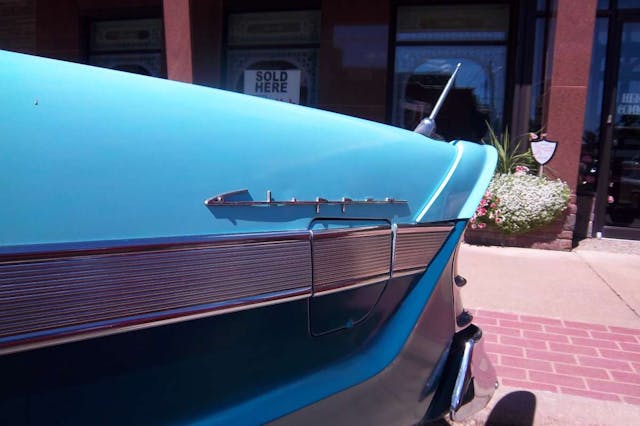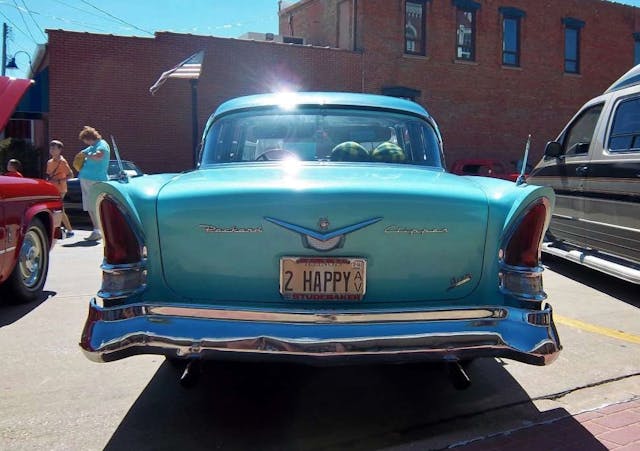Media | Articles
1957 Packard Clipper: I used to be somebody

Packard, Packard, Packard. What did you get yourself into? We could talk all day about the Studebaker-Packard marriage and its chaotic aftermath, but since it’s been talked to death here and elsewhere, here’s the short, short version: Packard never should have found itself in cahoots with cash-strapped, frequently clueless Studebaker. I love Studebaker dearly, but sometimes that can be a bit difficult, given what the company did to what was once America’s premier automobile.

As most of you know, a 1957 Packard is not really a Packard, but a “Packardbaker”—1956 was the last year for genuine Packards. Genuine meaning it was made in Detroit on the same line as the classic Twin Sixes of the 1930s, with no compromises in features, size, and luxury. Although the 1955 models had myriad assembly and mechanical problems, most of those had been corrected by ’56. Still, it was too little, too late. Actually, it had been too late even in 1954. At the very least, Studebaker was guilty of creative accounting and bookkeeping, and the resulting red ink became apparent only after Packard had bought out the Indiana company. Why Packard didn’t back out after getting a clear picture of Stude’s books is beyond me.

All that Packard cash (Packard was still in the black, with good cash reserves at the time of the merger) wound up being used to prop up Studebaker. Studebaker not only had a perilous history of kowtowing to the unions, but it had even issued shareholder dividends during the Great Depression—when the company was losing big money—with predictably disastrous consequences. The end result was a major financial crisis, followed by the closure of Packard’s venerable East Grand Boulevard factory. It may be of small comfort, but the 1956 Packard Patrician, Four Hundred, and Caribbean were well-built, finely crafted cars that held their own with Cadillacs, Imperials, and Lincolns. Sadly, the last real Packard came off the line on August 15, 1956, in Detroit.

I’ve already spent more time on Packard’s decline than I intended for this column; for a more thorough story, check out the ’58 Packard Hardtop column I wrote last year. My focus here is the 1957 “Packardbaker.” The 1957 South Bend-built Packard Clipper was essentially a 1957 Studebaker President Classic, Stude’s top- of-the-line model. It was quite different from Packard’s 1956 offerings.

For starters, it was smaller. The 1956 Packards were 218.6 inches long, with a 127-inch wheelbase. The ’57 model was 211.8 inches long with a 120.5-inch stretch between the wheels. That may not sound like a huge difference, but the ’57 Clipper was also an inch narrower. In fact, even the ’56 Packards were a bit narrow, owed to their 1951-vintage body shell. In comparison, the 1957 Cadillac Sixty Special (the model closest to the 1956 Patrician sedan) was 224.4 inches long, 80 inches wide, and had a 133-inch wheelbase. Going smaller in the American luxury car market was not the best choice in 1957.
Marketplace
Buy and sell classics with confidence

To give the S-P marketeers some credit, they did call it a Packard Clipper, a de facto admission that it wasn’t exactly a senior Packard. Which, of course, it wasn’t. Oh, there were plenty of Packard cues, including those oh-so-cool cathedral taillights (re-purposed 1956 Clipper units), broad chrome-side moldings, front bumper bombs (despite looking very much like Cadillac’s “Dagmar” bumper, they had been a Packard feature as early as 1951), and, of course, the red hexagon in the wheel covers.

The ’57 Clippers were introduced a little late, on January 31, 1957, in $3212 Town Sedan and $3384 Country Sedan (station wagon) form. There were no coupes, no convertibles. No lovely Caribbean. It is a virtual certainty that no one, least of all the Studebaker-Packard leadership, was fooled.
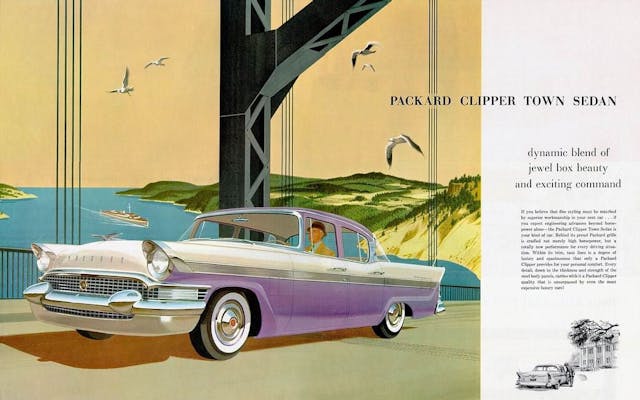
In truth, this car was intended to be a stopgap. At the time, S-P was trying mightily to secure financing for an all-new 1957 Packard that would use a common chassis and frame with planned new Studebakers, but feature different styling and wheelbases for the respective marques. Sadly, a complete lack of investor confidence left the company with no cash infusion in sight. The ’57 Clipper, along with mildly restyled ’57 Studebakers, was the result; it was all the automaker could afford at the time. A stopgap it was, but at least it was a rather attractive one.

Here’s the non-Packardized version: The $2539 Studebaker President Classic. The Classic, a sub-series of the top-trim President line, received a four-inch wheelbase stretch and the expected added trim and equipment. While it made for an extremely plush Studebaker, it wasn’t really Packard material. Nevertheless, as the best car Studebaker had to offer, so a Packard it would become.

That’s not to say the ’57 Clippers were bad cars—I like them, in fact, especially the wagon. Speaking of which, the Country Sedan, with a 116.5-inch wheelbase and 204.8-inch overall length, actually rode a shorter wheelbase than the sedan and was based on the President Broadmoor wagon. As previously mentioned, the Town Sedan, which was based on the Studebaker President Classic’s four-inch longer chassis, measured 211.8 inches stem-to-stern, with a 120.5-inch wheelbase.

One thing for which the ’57 Clipper needed no excuses for was its engine. Powering all 1957 Packards was a Studebaker OHV 289-cubic-inch V-8 fitted with a McCulloch Model VS-575 supercharger that engaged at 3000 rpm. Breathing through a two-barrel Stromberg carburetor, the setup was good for 275 horsepower at 4800 rpm.

Yes, you could have the very same engine as the vaunted Golden Hawk in your chrome-festooned wagon. I rather like the idea of a supercharged two-tone station wagon.
Clippers did look a little bit longer and lower than their Studebaker siblings, thanks in part to wide, grooved chrome side moldings that bisected their flanks (and continued across the tailgate in Country Sedans). Two-tone paint added to the longer and lower illusion compared to Studebakers.
Standard equipment included Flight-O-Matic automatic transmission, chrome wheel discs (adapted from the ’56 model), chrome drip moldings, back-up lights, a padded instrument panel (whose formed fiberglass cover was prone to warping over time), an electric clock, and front and rear carpeting. Not exactly the high specs of not-so-distant Packards, eh? Well, it was a Studebaker at heart. Nice enough, but, you know. Not super Broughamy, haha.

I mean, can you honestly imagine a traditional Packard owner buying one of these? They would have to be mighty loyal considering the competition. This was a painfully visible step down from the 1955–56 models, especially compared with the all-new 1957 Cadillac and fabulous ’57 Imperial.

The Batmobile-finned ’57 Lincolns were no slouches either and were available in a myriad of bright colors. I suppose some customers stuck with Packard, but it’s more likely that many made a lateral move to a Big Three luxury make—or perhaps to a Mercedes-Benz or Jaguar.
The closest comparison to the ’56 vs. ’57 Packard debacle that I can think of involves the downsized 1985 C-body Cadillac. Like the Packard, the Caddy suddenly seemed less prestigious than the Broughamed-out 1985 Town Car and, to a lesser extent, the Chrysler Fifth Avenue. Sure, the ’85 Fleetwood and deVille sold pretty well, but GM was wise to keep the traditional large-and-in-charge RWD Fleetwood Brougham in the lineup. Not everyone was enamored of the FWD Caddys, at least not until a restyling in 1989 made them more substantial. Sadly, Packard never got a second chance.
The standard equipment may not quite have been luxury car class, but plenty of options could be ladled on. Popular items included whitewall tires ($28), power steering ($98), power brakes ($38), power windows ($103), and a power front seat ($45). A limited-slip differential, Studebaker’s excellent Twin-Traction unit, was also available.
Inside, things looked a bit more Packard-like, with no Studebaker Cyclops-Eye speedometer present. Indeed, the gauges and instrument panel bore a striking resemblance to those in the 1955–56 Packards. Regrettably, the steering wheel was the usual Studebaker hand-me-down, albeit with a spiffy ship’s-wheel emblem.
I found this two-tone aqua and blue ’57 Town Sedan years ago at the Trains, Planes, and Automobiles car show in Geneseo, Illinois (fun fact: Geneseo is home to my favorite restaurant, The Cellar, which has been in business since 1960). The show attracts plenty of unusual cars; I highly recommend attending if you’re near the Quad Cities. The fare is most certainly not of the usual Tri-Five Chevy, GTO, and Mustang variety, and this Packardbaker proves it—as does the last-of-the-line ’66 Commander next to it. As one of only 3940 sedans built that model year, it’s a rare find in its own right. The wagon is even more scarce, with a mere 869 units produced.
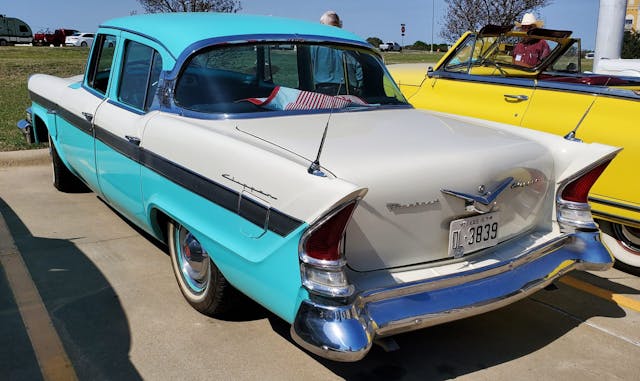
This white and turquoise example was found much more recently at a Packard meet, held earlier this year in Texas, by my friend Jayson Coombes. He relayed that it was a nice looking car, but parked next to the “true” 1955–56 Packards, it looked like it had been put in the dryer too long!

The 1957 model year was not good for Packard, nor S-P itself, as the company lost $43.3 million. Yikes. With no knight in shining armor bearing a line of credit, the 1957 new-car program was ditched. These 1957–58 Packards, meant to be an emergency stopgap model to keep the dealerships supplied, turned into the finale for a great marque. At S-P, the focus shifted to staying alive; never mind coming up with a new car. The questionable 1958 Packard face lift indicated just how crazy things were becoming.
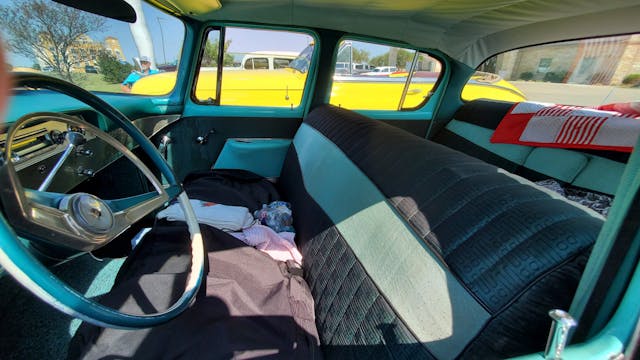
The 1957 Clipper may have looked nice enough for what it was, but the ’58 no-name Packard (the Clipper model name was dropped in favor of Packard Sedan, Packard Hardtop, etc.) was something else. While it does have a sort of kitschy-1950s appeal today, and I must admit I have a grudging love for them for their sheer late-’50s wackiness—who knows what new car buyers thought of it then! And along with the ’58 model (and a one-year-only Golden Hawk-based Packard Hawk), ladies and gentlemen, came the end of the Packard make.

